To further elaborate on my understanding of the horsemen from my last post, I thought it would be a good idea to discuss how I have applied them in my daily thinking and life. Over spring break, I visited my older brother who lives in Nashville, Tennessee. While I was there I visited the Parthenon Museum, an exact replica of the Parthenon in Athens, Greece that was built for the Tennessee Centennial Exposition in 1897. To my surprise, I was greeted by many pieces of art that have symbolism similar to themes that we have studied in our class—primarily the horsemen.
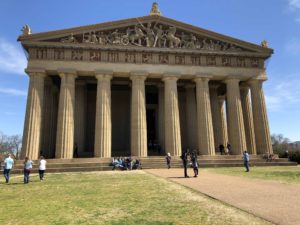
The east pediment on the outside of the museum represents the birth of Athena, the goddess of wisdom, handicraft, and warfare. According to Greek mythology, Athena’s birth was the product of great pain that Zeus was enduring. The pediment displays two horses on the outside of the pediment which symbolize the horses of Helios and Selene, deities of the sun and moon. In this case, the horses represent night and day which is fitting because Athena’s birth occurred at dawn. Although there’s seldom connecting references between Greek mythology and Biblical references (not forgetting Prince’s allusion to the Elysian Fields— a place in Greek mythology the gods would send deceased heroes to to immortalize them in his work, Katrina’s Dirge) I thought it was interesting to see the symbols Prince uses in other contexts.
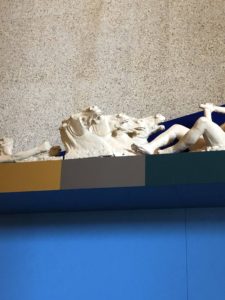
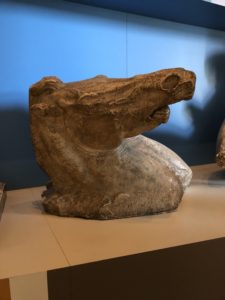
In Prince’s art, he uses the horsemen as drivers of change. Like we have seen in Katrina’s Dirge and Katrina’s Veil: Stand at the Gretna Bridge, the horsemen are carrying out a duty for others. In ancient Greek culture, the horses signify wealth in a thriving economy and an essential piece of warfare. The horsemen in Prince’s work wear fitted suits while the horses adorned on the pediment of the museum remain on all fours like the typical horses we see today.
The first exhibit inside the museum was an ode to the mosaic medium. Mosaic art is made by putting various materials like (but not limited to): stones, glass, shells, etc. together to create a design or picture. The exhibit continued its praise for Greek mosaics, yet still left room for more modern depictions. There was one music that immediately captured my attention was, The Three Horsemen by Julie Sperling. The plague on the wall read that the materials used in the piece included: slag, light bulb innards, shale, mortar tesserae, cement, marble, knob and tube, earphones, red dog, limestone, brick, architectural glass, ceramic, smalti, circuit board, resistors, coal, hard rubber, and gears. Even with the materials used you can tell the artist wanted a range of materials that primed in different eras to express how difference these eras are.
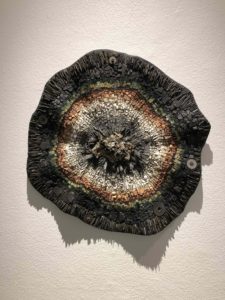
Julie Sperling discusses that before creating mosaics dealing with problems such as invasive species, pollution of all kinds, sea-level rise, and much more, they, “should probably take a look at the journey first before immersing myself in the destination. Thus, “The Three Horsemen,” or, how we got here.” In their statement, Sperling discusses the three ‘force multipliers’ or the three horsemen. The statement lists them as: one, the accelerated technological development, two, population increase which leads to a shift to urbanization, and lastly increased consumption of resources such as fossil fuels, minerals, metals, etc. The piece itself is a jumbled (but organized) mess of materials. The artist proclaims that we got here mainly due to ‘an explosion of people using things.’
The next mosaic piece that reminded me of our course was, Welcome to America, by Cindy Robin.
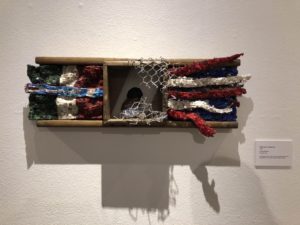
The piece used: smalti, kyanite, filato, copper, metal mesh, chain link, stained glass, dalle de verre, shell, and a vintage cabbage shredder. The piece shows the Italian flag on the left with a ripped or demented American flag on the far right. In the middle is a crying figure— most likely a child— surrounded by wire.
The artist’s statement reads:
We are a country of refugees. Fleeing religious persecution, seeking political asylum, escaping poverty, searching for a better life…
We come clinging to our dreams of acceptance and hope.
When did coming to America mean to separate families looking to us for help?
When did coming to America mean we rip children from their parents?
When did coming to America mean it is alright to put children in cages, frightened, alone, confused, sent to live with strangers?
Panama, Costa Rica, Nicaragua, Honduras, El Salvador, Guatemala, Belize, Mexico
Fleeing to our open arms?
When did this become who we are as a country?
This piece was created in response to the Trump May 2018 executive order “Zero Tolerance”.
This resulted in 2,300 children to be separated from their parents. Some children are forever lost in the system, never to see their families again” (Robin).
This piece in a way takes me back to Prince’s, Katrina’s Veil: Stand at the Gretna Bridge, which displays an artistic representation of racial segregation of those trying to cross the bridge to get out of the city.
DuBois’s, The Souls of Black Folk discusses the momentum of civil rights movements by using stories, songs, art and other narratives. When I read Robin’s artist’s statement (shown above), I thought about section IV of The Souls of Black Foul titled: Of the Meaning of Progress. An excerpt from this chapter that will always stand out to me is, “My log schoolhouse was gone. In its place stood Progress; and Progress, I understand, is necessarily ugly” (DuBois 73). America, a place previously viewed as a haven for opportunity and a better life to immigrants soon turned ugly by the Trump Administration’s “Zero Tolerance” approach to immigration enforcement laws. Under this approach, the Department of Justice is to prosecute adult illegal aliens with no exception to those seeking asylum or to those with minor children. These peoples who are found guilty are to be taken away and ultimately are separated from their minor children.
Using the knowledge that I have gained through this course has heightened my learning and understanding throughout my daily life. By appreciating the works of others you are gaining historical perspectives different than your own. Acknowledgment of the historical perspectives of others leads to creating small steps towards a future we can all live in.
